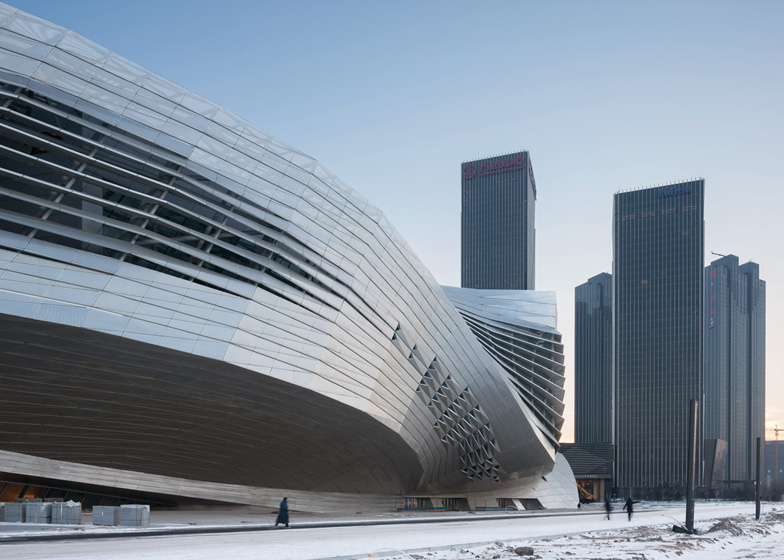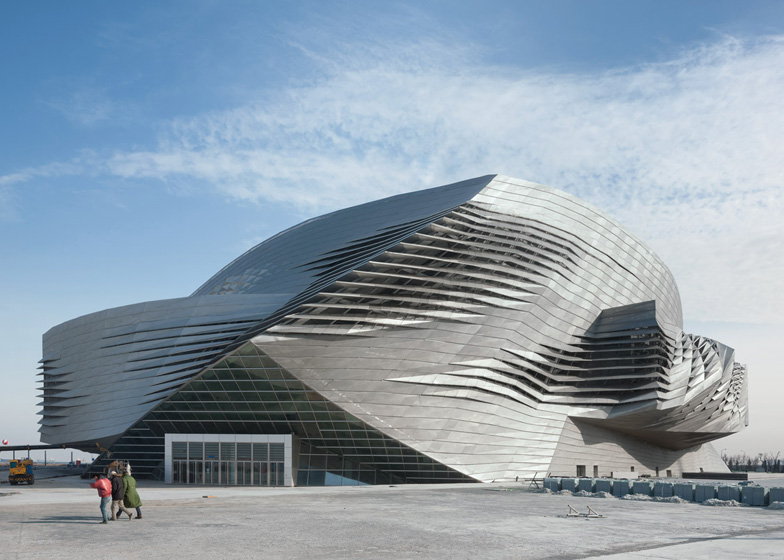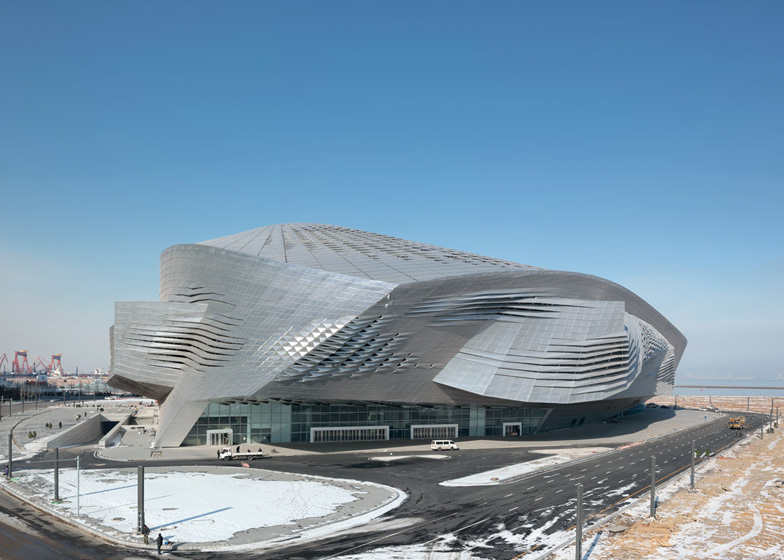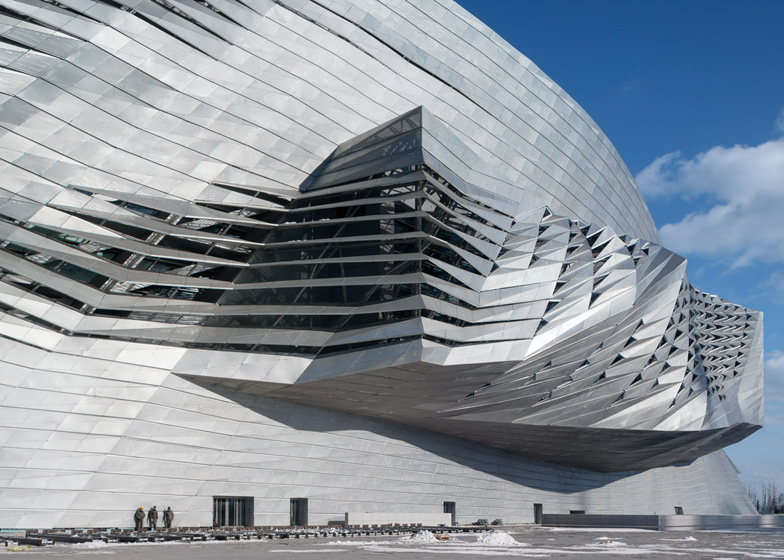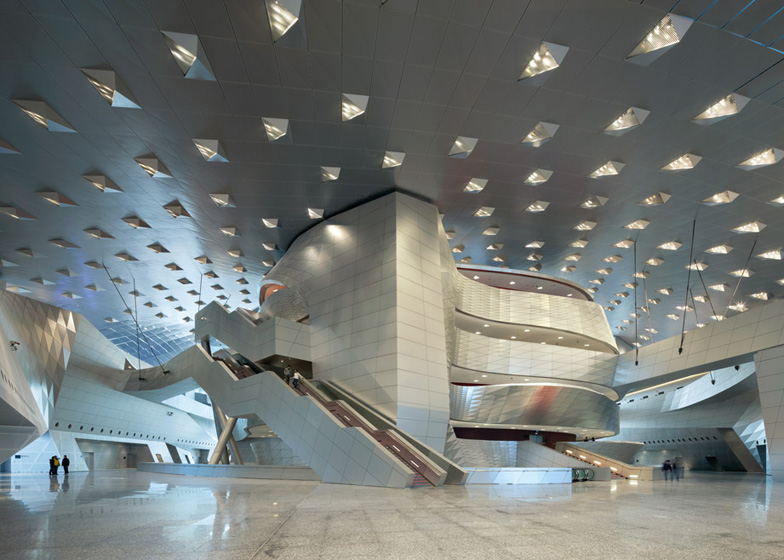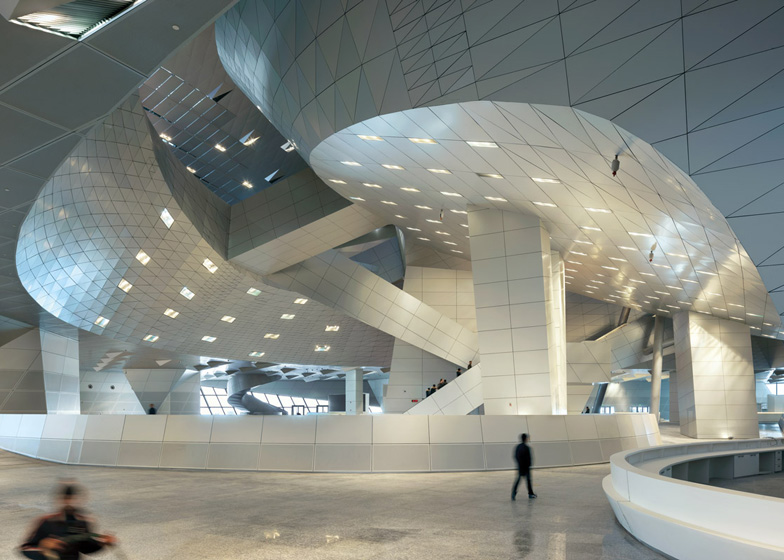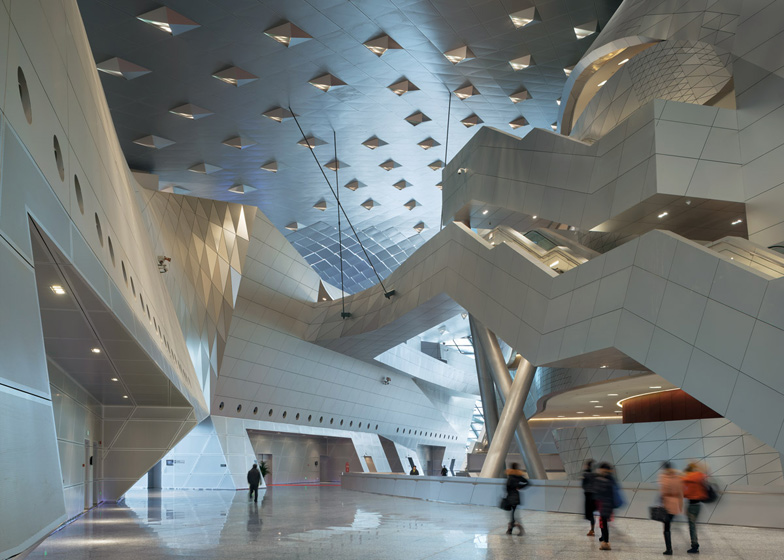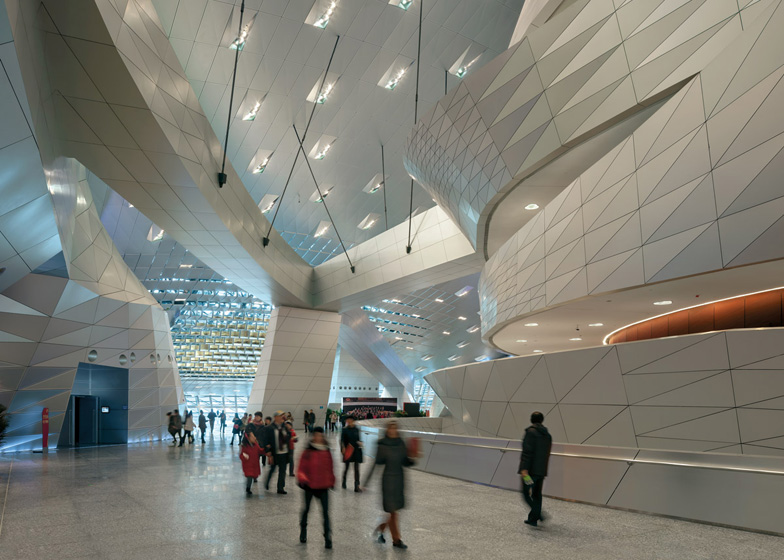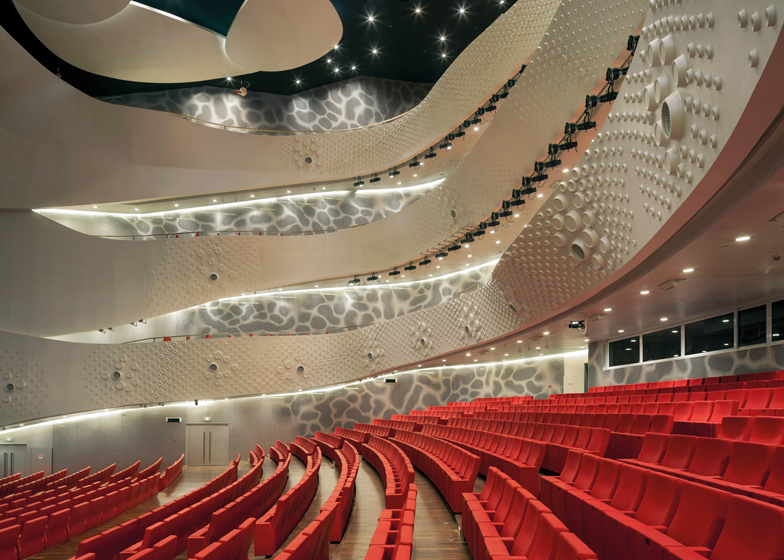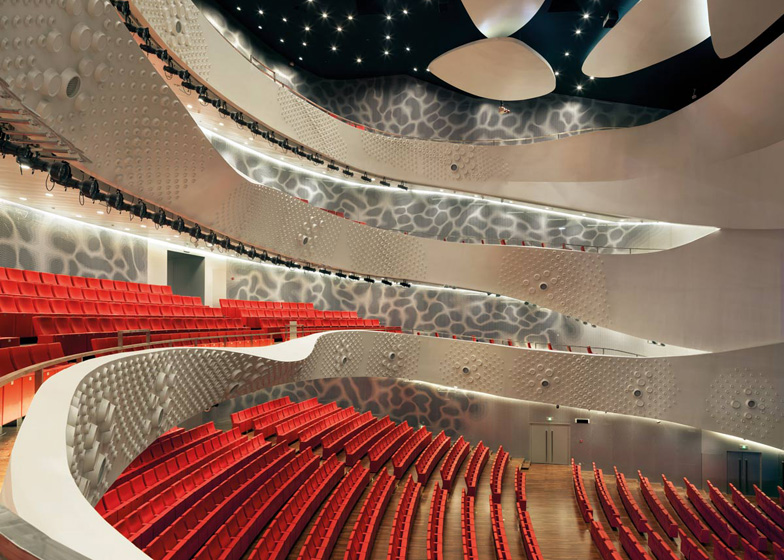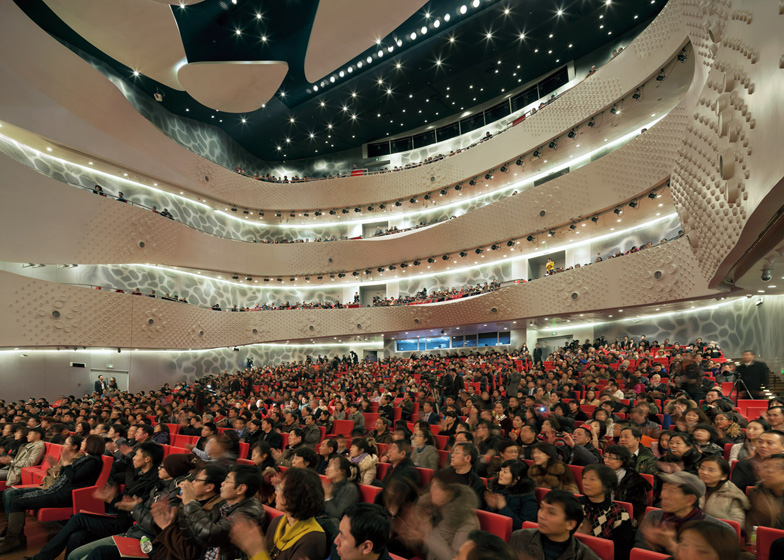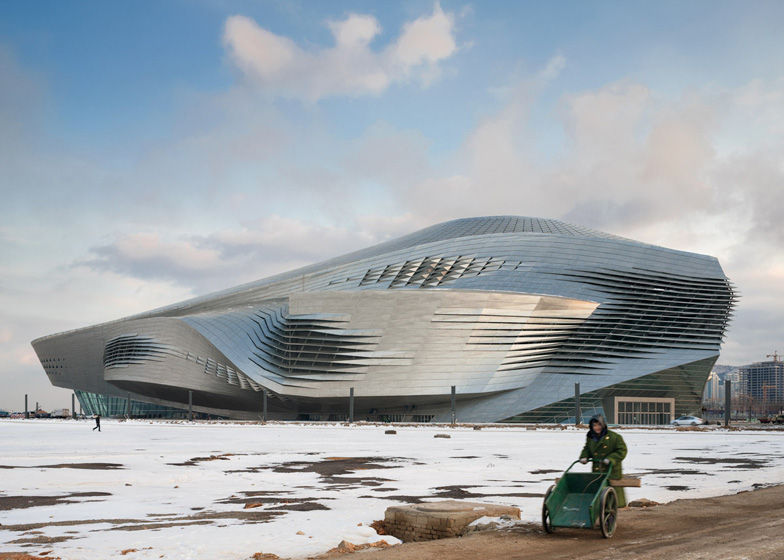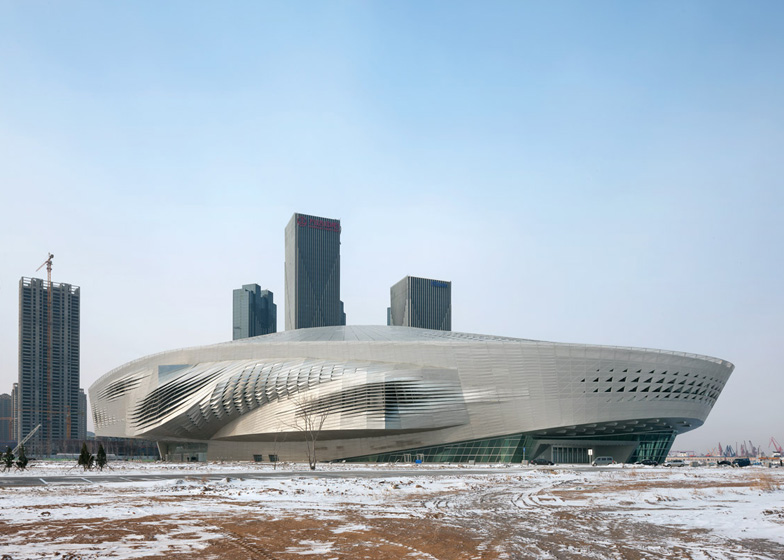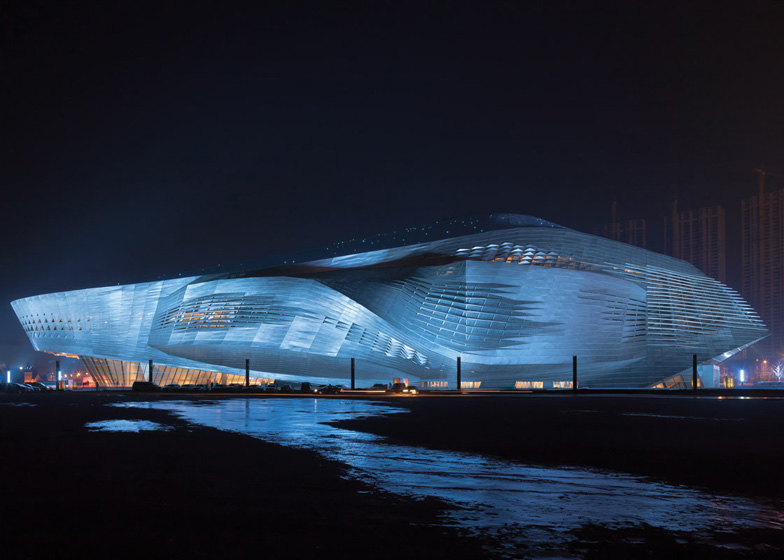Austrian firm Coop Himmelb(l)au has completed the Dalian International Conference Center, a contorted steel building in China with conference halls bursting through its facade.
The conference centre is constructed beside the harbour in the city of Dalian. Positioned at the far end of the city's main axis, the building was conceived as a landmark for the developing district outside the densely populated centre.
Coop Himmelb(l)au designed the building as a twisted mass of steel and concrete, with ridged surfaces that flare outwards like the gills of a bulbous fish. Behind these openings, large areas of glazing bring natural light inside.
The core of the building is a 1600-seat theatre and concert hall. The primary conference room is positioned just behind and can accommodate up to 2500 delegates, but can also be adapted to provide a banqueting hall, an exhibition gallery or extra seating for the concert hall.
Six additional conference suites are dotted around the perimeter of the building and cantilever out beyond the natural line of the exterior walls. The capacity of these rooms varies between 300 and 600 people, but most can be subdivided to create smaller spaces.
A public foyer winds through the building to connect each room, and also features a central meeting area.
Coop Himmelb(l)au won a competition in 2008 to design the Dalian International Conference Center. Construction commenced later that year and involved the help of shipbuilders, who were brought in to bend the massive steel plates of the outer shell.
Coop Himmelb(l)au is led by architect Wolf D. Prix, who last summer launched a scathing attack on the Venice Architecture Biennale for placing too much emphasis on celebrity. His studio also recently completed another grand-scale project in Asia - the Busan Cinema Centre in South Korea, which features a cantilever wider than the wings of an Airbus A380. See more architecture by Coop Himmelb(l)au.
Another major building proposed for Dalian in recent years was the football stadium designed by UNStudio, but this project has now been put on hold. See more stories about architecture in China.
Photography is by Duccio Malagamba.
Here's a more detailed project description from Coop Himmelb(l)au:
Dalian International Conference Center, Dalian, China (2008-2012)
The building has both to reflect the promising modern future of Dalian and its tradition as an important port, trade, industry and tourism city. The formal language of the project combines and merges the rational structure and organization of its modern conference center typology with the floating spaces of modernist architecture.
Dalian is an important seaport, industrial, trade, and tourism center, located in the southernmost part of the Liaodong Peninsula in the Chinese Liaoning Province. The city is currently undergoing a wave of transformation on coastal brownfield and reclaimed land which will entirely change the city's face within the next decade.
The key developments are:
» Dislocation of container port away from the dense city area
» Establishment of international port for cruise ships
» New development of a "CBD – Central Business District" on reclaimed land
» Bridge over the sea to connect with the special economic zone
The urban design task of the Dalian International Conference Center is to create an instantly recognizable landmark at the terminal point of the future extension of the main city axis. As its focal point the building will be anchored in the mental landscape of the population and the international community. The footprint of the building on the site is therefore arranged in accordance with the orientation of the two major urban axis which merge in front of the building. The cantilevering conference spaces that penetrate the facades create a spatially multifaceted building volume and differentiate the close surroundings. The various theaters and conference spaces are covered by a cone-shaped roof screen. Through controlled daylight input good spatial orientation for the visitors and atmospheric variety is assured.
The project combines the following functions within one hybrid building with synergetic effects of functionality and spatial richness.
» Conference Center
» Theater and Opera House
» Exhibition Center
» Basement with Parking, Delivery and Disposal
A public zone at ground level allows for differentiating accessibility for the different groups of users. The actual performance and conference spaces are situated at +15.30 m above the entrance hall. The grand theater, with a capacity of 1,600 seats and a stage tower, and the directly adjacent flexible conference hall of 2,500 seats, are positioned at the core of the building. With this arrangement the main stage can be used for the classical theater auditorium as well as for the flexible multipurpose hall. The main auditorium is additionally equipped with backstage areas like in traditional theaters and opera houses. This scheme is appropriate to broaden the range of options for the use of this space: from convention, musical, theater even up to classical opera, with very little additional investment.
The smaller conference spaces are arranged like pearls around this core, providing very short connections between the different areas, thus saving time while changing between the different units. Most conference rooms and the circulation areas have direct daylight from above. Through this open and fluid arrangement the theater and conference spaces on the main level establish a kind of urban structure with "squares" and "street spaces". These identifiable "addresses" facilitate user orientation within the building. Thus the informal meeting places, as well as chill-out and catering zones, and in between the halls, gardens with view connection to outside are provided as required for modern conference utilization. The access to the basement parking garage, truck delivery and waste disposal is located at the southwest side of the site, thus freeing the front driveway to the entrances from transit traffic. The main entrance from the sea side corresponds to the future developments, including the connection to the future cruise terminal.
Technical, Climatic and Environmental Concept
The focus of the architectural design and project development lies on technology, construction and their interplay. The technical systems fulfil the tasks required for the spatial use of the building automatically, invisibly and silently.
With the Dalian International Dalian Conference Center, these systems work like a hybrid city within a building. For the technical infrastructure of the building this means, that we have to consider a huge amount of people circulating inside the building at the same time, who expect high standards in circulation and comfort as well as a state of the art building with respect to high flexibility, low energy consumption and low use of natural resources.
Technical areas in the basement supply infrastructure within a rectangular grid, mainly inside the vertical cores. In particularly the conference zone has to be provided with a sufficient amount of air in order to maintain a high level of thermal and acoustical comfort. Therefore the conditioned air will be silently injected into the rooms via an inflated double flooring underneath the seating. Air blowout units inside the stairs will ensure consistent air distribution. Due to the thermal uplift, the heat of the people ascends to the ceiling and is extracted by suction.
Above: ground floor plan - click for larger image
One of the major tasks of sustainable architecture is the minimisation of energy consumption. A fundamental contribution is to avoid considerable fluctuations in demands during the course of the day. Therefore it is essential to integrate the natural resources of the environment like:
» Use the thermal energy of seawater with heat pumps for cooling in summer and heating in winter
» General use of low temperature systems for heating in combination with activation of the concrete core as thermal mass in order to keep the building on constant temperature
» Natural ventilation of the huge air volumes within the building allows for minimization of the mechanical apparatus for ventilation heating and cooling. The atrium is conceived as a solar heated, naturally ventilated sub climatic area.
» In the large volume individual areas can be treated separately by additional measures such as displacement ventilation
» A high degree of daylight use is aspired both for its positive psychological effect and for minimizing the power consumption for artificial lighting
» Energy production with solar energy panels integrated into the shape of the building.
Above: first floor plan - click for larger image
Structural Concept
The structural concept is based on a sandwich structure composed of 2 elements: the "table" and the roof. Both elements are steel space frames with depths ranging between 5 and 8 meters. The whole structure is elevated 7 meters above ground level and is supported by 14 vertical composite steel and concrete cores. A doubly ruled façade structure connects the two layers of table and roof, creating a load-bearing shell structure. The application of new design and simulation techniques, the knowledge of local shipbuilders to bend massive steel plates, and the consumption of more than 40,000 tons of steel enables breathtaking spans of over 85 meters and cantilevering of over 40 meters.
Above: second floor plan - click for larger image
Planning: COOP HIMMELB(L)AU - Wolf D. Prix / W. Dreibholz & Partner ZT GmbH
Design Principal: Wolf D. Prix
Project Partner: Paul Kath (until 2010), Wolfgang Reicht
Project Architect: Wolfgang Reicht
Design Architect: Alexander Ott
Design Team: Quirin Krumbholz, Eva Wolf, Victoria Coaloa
Above: third floor plan - click for larger image
Local Partner: DADRI Dalian Institute of Architecture Design and Research Co. LTD, UD Studio, J&A Interior Design
Above: fourth floor plan - click for larger image
Client: Dalian Municipal People’s Government, P.R. China
Structural Engineering: B+G Ingenieure, Bollinger Grohmann Schneider ZT-GmbH, DADRI Dalian Institute of Architecture Design and Research Co. LTD
Acoustics: Müller-BBM, Planegg
Stage Design: BSEDI Beijing Special Engineering Design and Research Institute
Lighting Design: a•g Licht, Wilfried Kramb
Above: fifth floor plan - click for larger image
Audio & Video: CRFTG Radio, Film and Television Design & Research Institute
Climatic Design: Prof. Brian Cody
HVAC, Sprinkler: Reinhold A. Bacher, DADRI Dalian Institute of Architecture Design and Research Co. LTD
Façade: Meinhardt Facade Technology Ltd.
Photovoltaic: Baumgartner GmbH
General Contractor: China Construction Eight Engineering Division
Above: sixth floor plan - click for larger image
Competition: 03/2008
Start of Planning: 07/2008
Start of Construction: 11/2008
Completion: 2012
Above: reflected ceiling plan - click for larger image
Site Area: 40,000 sqm
Gross Floor Area Conference Center: 91,250 sqm
Gross Floor Area Parking: 24,400 sqm
Gross Floor Area total: 117,650 sqm
Footprint: 33,000 sqm
Above: top view - click for larger image
Building Height: 60 m
Building Length: 220 m
Building Width: 200 m
Number of Floors: 8
Above: functional options - click for larger image
Above: climate design - click for larger image

